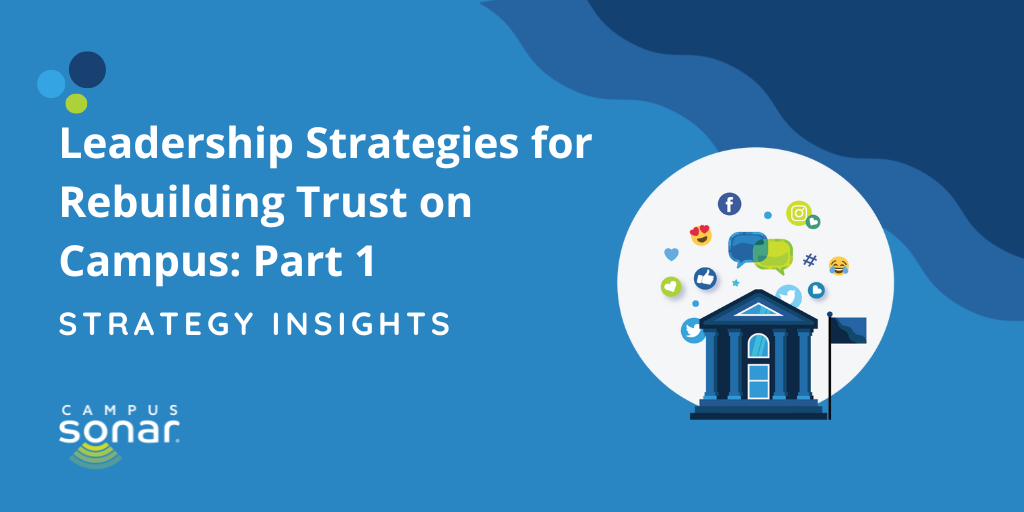Leadership Strategies for Rebuilding Trust on Campus: Part 1

In Campus Sonar’s latest industry trends report on “Rebuilding Trust in Higher Ed,” we explored the gap between trust and value to understand what audiences discuss about a college degree using social intelligence. We focused on how audiences explain the purpose of higher ed, the value of a degree based on current outcomes, and how those outcomes could evolve if trust and values aligned.
Now, it’s time to apply those insights on campus with strategies to help you begin rebuilding trust with prospective and current students, alumni, and the public at large.
Lead with Transparency
Transparency from campuses and their leaders is one way to gain credibility and rebuild trust with audiences. Former Nevada System of Higher Education Chancellor, Melody Rose, said: “There’s a lot of mystery about our industry. And the notion that we’re the ivory tower and are somehow distant from our communities, is, in part, a critique around transparency. Transparency builds trust. If we’re open and honest about the places where we need to improve, folks are more likely to trust.”
-1.png?width=1188&height=256&name=Prioritize%20Integrated%20Strategic%20Planning%20(7)-1.png)
Take Action
- Prioritize integrated strategic planning: Define a systematic process for actively addressing your campus pain points, perceived weaknesses, and barriers to understanding the financial aid and enrollment processes from the perspective of your admissions audiences.
- Partner with strategic planning teams—often the experts in change management on your campus—for an integrated approach to organizational change in support of overcoming these challenges.
- Need guidance for strategic planning on campus? Check out the Society for College and University Planning’s checklist.
- Simplify cost and aid conversations: Cost and financial aid were among the most pressing pain points shared in the data. Clearly communicate cost and value early and in spaces your audiences frequent. Early, transparent, and accurate cost estimates are imperative.
- Cut through the noise and share estimated tuition, fee, and expense costs up front alongside clear benefits—including typical aid packages so the bottom line is clear. Seek opportunities to simplify the steps that lead to those estimates—added complexities are burdens to access.
- The ongoing delays, technical issues, and user experience challenges with the Free Application for Federal Student Aid (FAFSA) has exacerbated trust as it relates to cost and value. (And these issues aren’t new as of the 2023–24 form changes—the U.S. Department of Education has historically created access challenges for students as a direct result of this step in the financial aid process.) With so many themes centered around outcomes, ROI, cost, and value as reasons for declining trust in or questions of higher ed in the online conversation, this added setback only extends those questions and distrust. Even though this is an industry-wide problem, you have an opportunity on your campus to take a human-centered approach in what happens next as a way to begin building back some trust, which will only differentiate your campus in comparison to its peers and competitors.
- Differentiate your campus offerings with realism and transparency. Your mission and brand voice come into play here!
- Identify what your campus genuinely does best and tell that story with specificity and personal narratives. Then, tailor your recruitment strategy to recruit students who align with it.
Frame Messaging with Outcomes
Increased job prospects, greater employer benefits, higher earning power, social mobility, and marketplace contributions were all themes from the purpose and value conversations. Campuses have a clear path forward to align their operations and messaging in support of these individual, community, and societal outcomes.
-1.png?width=1185&height=262&name=Prioritize%20Integrated%20Strategic%20Planning%20(4)-1.png)
Take Action
- Leverage data: Use the data available to you—graduation data, job placement data, alumni data. Ensure data infrastructures are constructed in ways that allow for accessible, actionable insights and data storytelling. Systemize your collection of and your campus’s access to alumni data to inform marcomm strategy and leverage your resources effectively across teams.
- Tell your alumni stories: Amplify alumni stories with positive professional, philanthropic, and community engagement outcomes. Spotlight alumni who align with your brand, differentiators, and values to stay true to your campus culture and differentiate your campus and its individual academic offerings.
- Alumni are loyal brand advocates—especially on social. Leverage their brand affinity from user-generated content by illustrating their first-person experiences and perspectives and connecting them with individuals who need to hear it to extend the value of your campus network.
- Maximize your alumni news strategy. Ensure alumni news mentions are captured systematically—these sources are rich in data about career shifts and philanthropic contributions. Pitch alumni news stories (and repurpose those published by the news media) to broaden brand awareness to expand authenticity from third-party sources.
- Engage your community: Form community partnerships with established industries and small businesses to identify employer needs, inform economic development, and support career pipelines in your campus’s region. Alumni business leaders and their networks can be an asset in this endeavor, too.
We have two more strategy recommendations to share—check out Part 2.
Your Next Steps
- Download the Rebuilding Trust in Higher Ed report for comprehensive insights into the general public’s perception of higher ed.
- Listen to industry experts discuss growing brand equity on campus.
- Explore ways to work with us to apply these insights and strategies at your campus.
